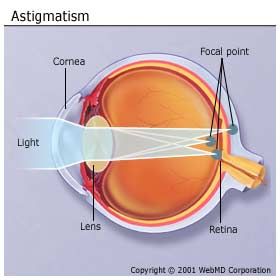
Astigmatism is a condition that causes blurry vision due to the irregular shape of the clear front covering of the eye or the cornea. In some cases, it’s due to the lens inside the eye being curved. If your lens or cornea is irregularly shaped, light will not be able to properly focus on your retina, so vision becomes blurred.
This is a very common condition- most people do have some level of astigmatism. However, a slight amount of astigmatism typically will not affect vision and therefore will not require treatment. On the other hand, if you do have a high level of astigmatism, you may have blurred/distorted vision, headaches, and even eye discomfort.
In order to diagnose astigmatism, an optometrist will have to do a comprehensive eye exam. Then, he/she will be able to offer contacts or eyeglasses that will correct the condition by altering the way light is entering your eyes.
If you don’t want to have to deal with contact lenses or glasses for the rest of your life, you can ask about a procedure known as Ortho-K, or orthokeratology. This is a corneal modification procedure that requires you to wear a series of specifically designed contact lenses to gradually reshape your cornea.
Another great option for treating astigmatism is laser surgery. Through this procedure, the shape of your cornea is changed with removal of a very small amount of tissue. The tissue is removed using a very highly focused laser beam on the surface of your eye.
Causes of Astigmatism
As you already know, this condition is due to the lens of your eye or your cornea being irregularly shaped. The lens and cornea are responsible for focusing the light as it enters your eyes, which helps you to see more clearly.
Astigmatism could develop after you have eye surgery or experience an injury to your eye. In addition, a relatively rare condition, known as keratoconus, results in the cornea becoming thinner and cone-shaped over time. If you have this rare condition, you will most likely need contacts to help you see clearly and eventually, you are likely to need a corneal transplant.
Diagnosing Astigmatism
In order to diagnose astigmatism, the optometrist will need to perform a comprehensive eye exam. Testing will measure the way your eyes focus light and will help to determine the strength of glasses or contacts you will need to correct your vision. Some common tests include:
1) Visual acuity: in this test, you will read letters on a distance chart. Visual acuity is written as a fraction, with the top number being the standard at which testing is done and the bottom number is the smallest letters you could read. This means that if your vision is 20/40, you can read at 20 feet what should be able to be seen clearly at 40 feet. Normal vision is 20/20.
2) Keratometry: in this test, an instrument known as keratometer will be used to measure the curvature of your cornea. A circle of light will be focused on your cornea and the reflection measured to determine exactly how much your cornea is curved. A precise measurement is critical for getting the proper fit for contacts.
3) Refraction: in this test, an instrument called a phrotopter is used to place a series of lenses in front of your eyes to measure how well light is focused. A lighted instrument known as a retinoscope will be used to evaluate the way your eye is focusing. You will also be able to tell the optometrist which lenses help you see more clearly.
The information found in these tests will help your optometrist to determine whether or not you are dealing with astigmatism. This will help him/her to determine how strong your contacts or glasses need to be to give you clear and comfortable vision as well as other possible options to correct your vision.

Comments are closed.